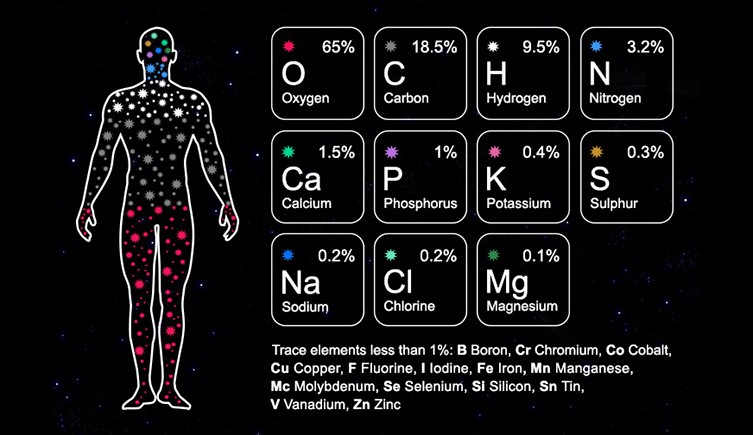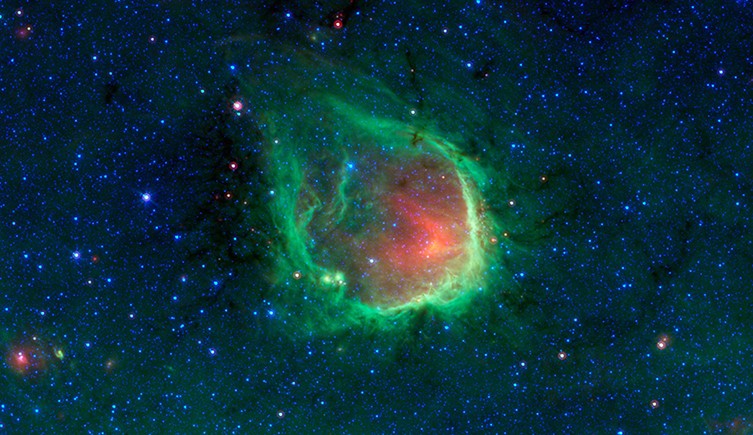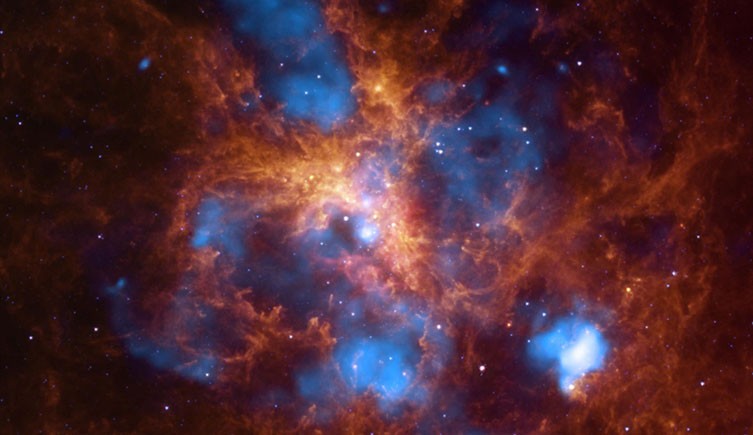Create a list of articles to read later. You will be able to access your list from any article in Discover.
You don't have any saved articles.

The Veil Nebula is 110 light years across. It is the remnants of a massive star supernova that exploded about 8,000 years ago. This small section of the nebula was captured by the Hubble Space Telescope. The colours correspond to different gases – oxygen is blue, hydrogen is red and sulphur is green. © NASA/ESA/HHT
Stars that go supernova are responsible for creating many of the elements of the periodic table, including those that make up the human body.
Planetary scientist and stardust expert Dr Ashley King explains.
'It is totally 100% true: nearly all the elements in the human body were made in a star and many have come through several supernovas.'

Most of the elements that make up the human body were formed in stars
We think that the universe began 13 or 14 billion years ago, with the Big Bang. At that point only the lightest elements existed, such as hydrogen, helium and minuscule amounts of lithium.
Elements are matter that cannot be broken down into simpler substances. On the periodic table, each element is distinguished by its atomic number, which describes the number of protons in the nuclei of its atoms.
The first generation of stars formed as lumps of gas drew together and eventually began to combust. This would cause a nuclear reaction in the centre of a star.
The first stars that formed after the Big Bang were greater than 50 times the size of our Sun.
'Inside stars a process takes place called nucleosynthesis, which is basically the making of elements,' Ashley says. 'The bigger the star, the faster they burn their fuel.'
The first stars burned their fuel quickly and were able to make only a few elements heavier than hydrogen and helium. When those stars went supernova - exploded powerfully - and expelled the elements they had produced, they seeded the next generation of stars.
Scientists can tell the temperature and age of stars from their colour. Hotter stars burn blue, while cooler and older stars burn red.

NASA's Spitzer Space Telescope shows the infrared 'glow' of the gas and dust ring surrounding Nebula RCW 120 in Scorpius © NASA
The next generation of seeded stars were then able to produce other, heavier elements such as carbon, magnesium and nearly every element in the periodic table. Any element in your body that is heavier than iron has travelled through at least one supernova.
'So it's very likely that there are a whole bunch of different stars that have contributed the elements we see in our own solar system, our planet and those found within you.'
The burning that takes place inside stars draws on a huge amount of fuel and creates an enormous amount of energy.
'Stars are immense objects - over 99% of the mass in our solar system is in our Sun - and gravity squeezes them. Meanwhile, the burning inside a star creates energy which counteracts the squeeze of gravity which is why our sun is stable.'
Stars stay in this equilibrium with gravity until they run out of fuel.
'When that happens to really big stars you can get some really, really spectacular supernovas,' Ashley says. 'Our own Sun won't be anywhere near as dramatic as that.'

The Tarantula Nebula, also known as 30 Doradus, is a star-forming region in the Large Magellanic Cloud, a small galaxy close to the Milky Way. About 2,400 massive stars in the centre of the nebula produce intense radiation and powerful 'winds' of ejected material. X-rays are shown in blue, produced by superheated gases, resulting from supernova explosions and stellar winds. This multimillion-degree gas carves out giant bubbles in surrounding cooler gas and dust.
When stars die and lose their mass, all the elements that had been generated inside are swept out into space. Then the next generation of stars form from those elements, burn and are again swept out.
'This constant reprocessing of everything is called galactic chemical evolution,' Ashley says. 'Every element was made in a star and if you combine those elements in different ways you can make species of gas, minerals, and bigger things like asteroids, and from asteroids you can start making planets and then you start to make water and other ingredients required for life and then, eventually, us.'
'This process has been going on for something like 13 billion years and our solar system is thought to have formed only 4.5 billion years ago.'

The Pillars of Creation are formations of interstellar gas and dust in the Eagle Nebula. Astronomers have combined several Hubble Space Telescope exposures to assemble this view. The colours highlight emissions from several chemical elements. Oxygen emissions are blue and sulphur orange, and hydrogen and nitrogen appear green. © NASA/ESA/HHT
Large stars last for a few million years, while smaller stars more than 10 billion years.
'You can't really watch a star form and see what happens in real time. When you look at the stars through a telescope what you're seeing probably happened millions of years ago,' Ashley says. 'You can tell some things about their make-up based on colour and temperature, but not everything.
'In 1987 there was a supernova that actually made it possible for scientists to watch and record a ring of material being ejected, but this kind of occurrence is rare.'

Captured by NASA's Spitzer Space Telescope in 2011, this image of the North America Nebula shows a cluster of young stars (about one million years old). The nebula gets its name from having a shape similar to the North American continent. © NASA/JPL-Caltech
The other way to study the life cycle of stars is by finding samples of cosmic dust and observing them through an electron microscope.
Invisible to the human eye, a single speck of this very pure, original stardust (known as a pre-solar grains, because they are older than our Sun) is only a few microns in size - 100 times smaller than the width of a human hair.

A single pre-solar grain viewed through an electron microscope
'We find it in the really, really pristine, primitive meteorites that were never altered on asteroids in the early solar system,' Ashley says. 'It is like looking for a needle in a whole field of haystacks.'
Essentially, a scientist must take a tiny chip of a primitive meteorite and dissolve 99.9999% of it until they're left with a residue of silicon carbide, graphite and nanodiamonds. Things that are made at high temperatures in the atmosphere of stars are resistant to acid and therefore left behind.
Most of the elements of our bodies were formed in stars over the course of billions of years and multiple star lifetimes.
However, it's also possible that some of our hydrogen (which makes up roughly 9.5% of our bodies) and lithium, which our body contains in very tiny trace amounts, originated from the Big Bang.
... or that it helped you learn something new. Now we're wondering if you can help us.
Every year, more people are reading our articles to learn about the challenges facing the natural world. Our future depends on nature, but we are not doing enough to protect our life support system. Pollution has caused toxic air in our cities, and farming and logging have wreaked havoc on our forests. Climate change is creating deserts and dead zones, and hunting is driving many species to the brink of extinction. This is the first time in Earth's history that a single species - humanity - has brought such disaster upon the natural world. But if we don't look after nature, nature can't look after us. We must act on scientific evidence, we must act together, and we must act now.
For many, the Natural History Museum is a place that inspires learning, gives purpose and provides hope. People tell us they 'still get shivers walking through the front door', and thank us for inspiring the next generation of scientists. To reverse the damage we've done and protect the future, we need the knowledge that comes from scientific discovery. Understanding and protecting life on our planet is the greatest scientific challenge of our age. And you can help.
We are a charity and we rely on your support. No matter the size, every gift to the Museum is critical to our 300 scientists' work in understanding and protecting the natural world. From as little as £2, you can help us create a future where both people and the planet thrive. Thank you.